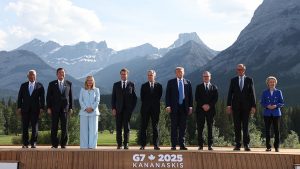Talking Shop

Normally, negatives do not make headlines. But, at times, they do. The recently concluded G7 summit in Alberta, Canada, turned out to be one such event when what did not happen mattered more than what did. The most crucial thing that did not take place was that the summit could not issue a joint communiqué that starkly illustrates the deepening policy divisions among leaders of the world’s most powerful economies. There is already a raging debate on what the G7 can accomplish amid growing US-European tensions. But, after the failure to prepare a joint communiqué, a more fundamental question has emerged: Is the G7 itself equipped to address today’s complex geopolitical landscape?
The summit exposed significant rifts between G7 members and the US on critical international issues. Trump’s assertion that ejecting Russia from the former Group of Eight (G8) was a strategic mistake exacerbated tensions over Russia’s war in Ukraine. The G7 did endorse a statement for “de-escalation of hostilities, including a ceasefire in Gaza,” but watered-down statements like this reveal the challenges in achieving consensus. These parallel conflicts show not only internal G7 divisions but also the growing disconnect between G7 positions and broader global sentiment, especially when it comes to Israel and Gaza.
The lead-up to the Kananaskis summit threw up another critical question whether the G7 can remain relevant while excluding major global players. It is not difficult to surmise that pressure from some quarters ultimately compelled Canadian Prime Minister Mark Carney, however unwilling, to extend an invitation to Prime Minister Narendra Modi, despite ongoing diplomatic tensions over last year’s killing of Nijjar, a suspected Khalistani supporter in British Columbia. This last-minute inclusion brings out the reality that India’s absence from G7 discussions would barely, if at all, impact any outcome, even though it is one of the world’s largest consumer economies.
But, more troubling development is the weakening of the shared democratic values that supposedly bind the G7 together. The Trans atlantic relationship faces unprecedented strain as the Republican Party, under the leadership of Trump and Vice President JD Vance, increasingly views liberal European societies as divergent from American values and interests. This ideological drift threatens the very foundation upon which the G7 was built.
Trouble was brewing even before Trump’s early departure from the leaders’ summit and the final absence of a communiqué. Trump’s trade policy had already effectively led to the formation of a coalesced European, Canadian, and Japanese front against the US. But the fracture in the G7 has only become more evident during the summit itself. When the group had come into being 50 years ago, its avowed aim was to become a channel for economic coordination between the world’s largest economies. In recent years, the conflict between Ukraine and Russia injected more energy into the G7, which had functioned as a pivot for sanctions coordination and strategising on supporting Ukraine. But the development angered Trump so much that he went to the extent of asserting that Russia should be brought back into the G8 fold, further exposing the lack of alignment between him and the other leaders.
Of course, there were agreements to combat what the leaders called non-market policies that could block access to critical minerals and also limit the downsides of artificial intelligence on jobs and the environment, without shutting their eyes to the technological revolution. But these gains are far outweighed by the failure to project the G7 as a cohesive, united forum.
It seems the G7 is now in the midst of a geopolitical crisis, as the Israel-Iran conflict plays out and the US’ strained relationship with the rest of the group shows the deep fissures within. Even as France is set to take on the presidency in 2026, its relevance will largely depend on how much value Washington sees in collaborating with its closest allies on economic issues.
A forum designed for the world’s democratic economic powerhouses now struggles to find significant meeting grounds. The G7 is virtually turning out to be an increasingly irrelevant talking shop unable to address many of the defining challenges of the twenty-first century. In the midst of all this turmoil, India, whose democratic credentials are being questioned worldwide, seems rudderless in its foreign policy and global outlook.
News